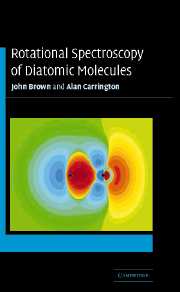Book contents
- Frontmatter
- Contents
- Preface
- Summary of notation
- Figure acknowledgements
- 1 General introduction
- 2 The separation of nuclear and electronic motion
- 3 The electronic Hamiltonian
- 4 Interactions arising from nuclear magnetic and electric moments
- 5 Angular momentum theory and spherical tensor algebra
- 6 Electronic and vibrational states
- 7 Derivation of the effective Hamiltonian
- 8 Molecular beam magnetic and electric resonance
- 9 Microwave and far-infrared magnetic resonance
- 10 Pure rotational spectroscopy
- 11 Double resonance spectroscopy
- General appendices
- Author index
- Subject index
Preface
Published online by Cambridge University Press: 17 December 2010
- Frontmatter
- Contents
- Preface
- Summary of notation
- Figure acknowledgements
- 1 General introduction
- 2 The separation of nuclear and electronic motion
- 3 The electronic Hamiltonian
- 4 Interactions arising from nuclear magnetic and electric moments
- 5 Angular momentum theory and spherical tensor algebra
- 6 Electronic and vibrational states
- 7 Derivation of the effective Hamiltonian
- 8 Molecular beam magnetic and electric resonance
- 9 Microwave and far-infrared magnetic resonance
- 10 Pure rotational spectroscopy
- 11 Double resonance spectroscopy
- General appendices
- Author index
- Subject index
Summary
A book whose title refers to the spectroscopy of diatomic molecules is, inevitably, going to be compared with the classic book written by G. Herzberg under the title Spectroscopy of Diatomic Molecules. This book was published in 1950, and it dealt almost entirely with electronic spectroscopy in the gas phase, studied by the classic spectrographic techniques employing photographic plates. The spectroscopic resolution at that time was limited to around 0.1 cm−1 by the Doppler effect; this meant that the vibrational and rotational structure of electronic absorption or emission band systems could be easily resolved in most systems. The diatomic molecules studied by 1950 included conventional closed shell systems, and a large number of open shell electronic states of molecules in both their ground and excited states. Herzberg presented a beautiful and detailed summary of the principles underlying the analysis of such spectra. The theory of the rotational levels of both closed and open shell diatomic molecules was already well developed by 1950, and the correlation of experimental and theoretical results was one of the major achievements of Herzberg's book. It is a matter of deep regret to us both that we cannot present our book to ‘GH’ for, hopefully, his approval. On the other hand, we were both privileged to spend time working in the laboratory in Ottawa directed by GH, and to have known him as a colleague, mentor and friend.
- Type
- Chapter
- Information
- Rotational Spectroscopy of Diatomic Molecules , pp. xv - xviiiPublisher: Cambridge University PressPrint publication year: 2003

